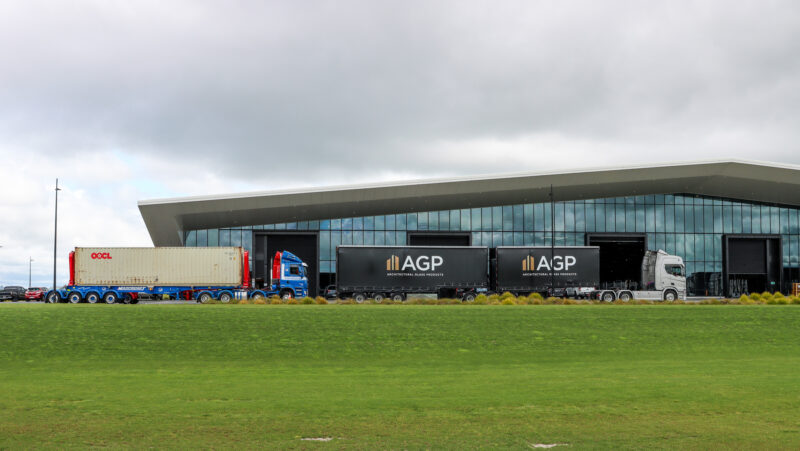World-class technology and outstanding culture at Architectural Glass Products
Architectural Glass Products (AGP) is a cutting-edge glass manufacturing business based in Hautapu, near Cambridge.
Established five years ago, AGP was created to help provide the APL window manufacturer network with a total window solution. It was born from the belief that the local window and glass industry was being underserved, particularly in terms of service and quality.
In response, David Bunting, Mitch Plaw, Craig Vincent and Brent Martin joined forces to create a world-class, fully digitalised, and highly automated double-glazing operation.
The result is a custom-built, state-of-the-art facility stretching 417 metres long and 108 metres wide, home to some of the most advanced glass processing equipment in the Southern Hemisphere.
The Employers and Manufacturers Association’s Nicholas Russell sat down with David to discuss the challenges and successes of launching a greenfield manufacturing operation in New Zealand, the pivotal role of digital transformation, and the importance of investing in people and culture from day one.
Why was AGP started??
We felt the glass and window industry in New Zealand was underserved – quality was lacking, and service wasn’t up to par. Our customers, being APL Window Manufacturers, were feeling the pain and we realised the only way to truly improve the supply chain experience was to control it ourselves.
That meant starting from scratch and building a manufacturing business that could deliver exceptional products with equally exceptional service.
AGP is known for its massive and innovative facility. Can you tell us about the design thinking behind it?
We designed the building around the manufacturing process, not the other way around. That gave us complete freedom to optimise product flow and efficiency. The building is 417 metres long (you could park five Boeing 777s inside with room to spare) and 108 metres wide, which helped us futureproof our operations. Aesthetically, it looks better too, but the real driver was efficiency and flexibility.
We grew into most of that space within our first few years. Ultimately, everything was designed and built to support our window system manufacturers and, in turn, their customers.
Automation is clearly a huge part of your story. What has that journey looked like?
From day one, we set out to build a highly automated business. Our factory runs with just 110 people, which is very low considering the size and scale. We made a conscious decision to strike the right balance between automation and human oversight. Too much automation, too soon can strangle a business if the systems fail or your team isn’t trained to support them.
We’ve leaned into Industry 4.0 thinking, focusing heavily on software as well as machinery. We chose a turnkey system from an Austrian company called Lisec, which gave us not just the equipment but a full software stack that helps us manage production digitally end to end. That’s where the real innovation lies – software, not just hardware.
What were some of the toughest challenges in that digital ramp-up?
Even with a greenfield site, where we didn’t have to retrofit anything, the learning curve was steep. There’s a scarcity of local expertise in this type of advanced automation, so we had to build it ourselves. That meant hiring people with the right attitude and training them from scratch. It takes energy, time, and commitment, but you have to build those skills internally if you want the automation to be sustainable.
What role has culture played in AGP’s success?
Culture is everything. It’s what separates us from other companies. We built AGP with a very flat structure: no unnecessary bureaucracy, no silos. Everyone wears the same uniform, sits in the same open office environment, and has the right to challenge decisions. Decision rights are respected, and those rights are earned based on comparative advantage, not hierarchy.
That mindset allows us to unlock contributions from across the business. I’ve seen people shift from IT into finance roles and thrive. That’s the sort of flexibility and empowerment that keeps people engaged.
How do you approach recruitment and training?
Recruitment is a challenge for everyone, and we’re no different. But we don’t look for glass industry veterans, we hire for attitude and train for skill. Most of our people came in without any glass experience. That gives us a blank canvas to shape a team that fits AGP’s culture.
We’re very deliberate about what we teach and how we teach it. We show people what great looks like and what’s not acceptable. That helps us build and maintain a high-performance culture.
What advice would you give to others starting a manufacturing business in New Zealand?
There are always small issues early on that can seem minor, but as you scale, those same issues can become existential threats. Fix them early. Don’t wait until they’re big enough to kill your momentum.
And above all, invest in your culture and organisational capability. That’s what sustains you in both the good times and the bad. If you don’t get that right, no amount of automation or capital investment will save you.
How has your EMA membership been useful during AGP’s journey?
Around complex areas like immigration, as we struggled to find the staff we needed locally. We had real challenges in that space with not enough internal experience to navigate the policies and processes effectively. We’re members of the Employers and Manufacturers Association and we leaned on their Advocacy team for help with this issue. Their assistance was critical. It helped us understand our options and move forward when we were stuck.



